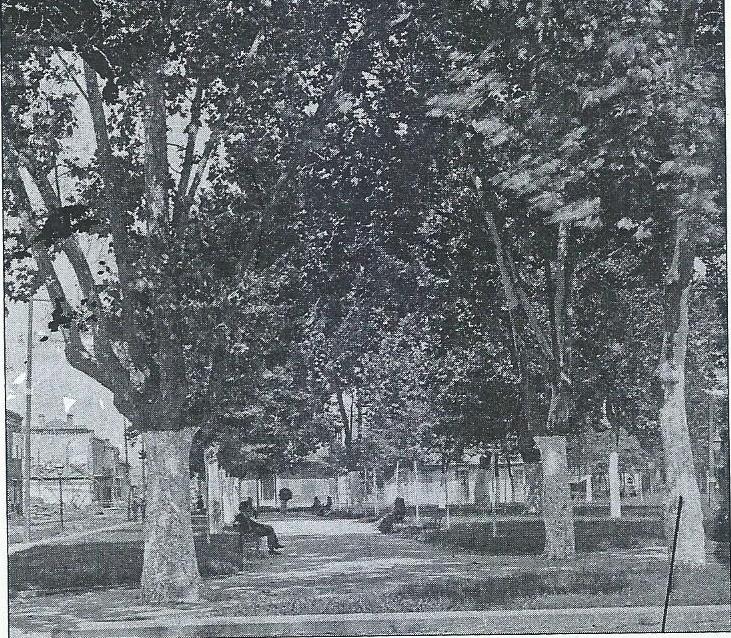Congo Square, circa 1890-95
On the afternoon of April 13, 1891, Joseph Mansion, an undertaker at #88 Bourbon Street, received a long hand written letter sent to him by a very close friend, Alfred Jourdain. The letter, written in French, stated:
My Dear Mansion:
“As life is very uncertain, it is perhaps wise to make known one’s wishes before it is too late. In case of anything happening to me, I desire that my body shall be exposed at the hall of the Economy Society on Bourbon between Marais and Villere Streets. The benefits from the several benevolent organizations to which I belong will bring about $450.00. Spend no more than $75.00 of this sum for my funeral expenses. I have two debts to pay totaling $54.75.The remainder of the money you will kindly deliver to my daughter, Alice. Our mutual friend, John Staes, will furnish you all needed information relative to my child. With regards to my shop, I would prefer that my partner, Edouard LeBourgeois, should be the purchaser of my portion. All of this can be done, I dare say, without recourse to law. Bid good-by to my friends for me. Thanking you in advance for your kindness, I am your friend…… A. Jourdain.”
Upon reading the letter, Undertaker Mansion started out to hunt up Jourdain. He first went to his barber shop at #14 Royal Street, but discovered he had left there in the morning. He ran quickly to several other places, but at each Jourdain had already left.
Shortly before 5 o’clock, he encountered one of Jourdain’s workmen who informed him that he had seen him in the confectionary shoppe at the corner of St. Peter and Rampart Streets. He also added that the undertaker needed to get there right away and talk to him.
Suddenly, someone shouted, “Look at Jourdain, he is now going across the square!” Mansion looked up and, sure enough, there was Jourdain walking toward St. Claude Street. As Mansion hurried over to meet his friend, Jourdain walked to a bench on the St. Peter Street side of the square and took a seat. In an instant, Alfred Jourdain put his hand on his hip and, as he sat upon the bench, pulled a 38-caliber, double action forehand revolver from his pocket. In an instant, he placed the muzzle of the pistol to his right ear and pulled the trigger.
Mansion ran to him and caught him in his arms. He asked him what he had done but his friend gave no answer. Everything was now over! The bullet lodged in the right side of Jourdain’s head. It proved to be a mortal wound.
Special Officer Flotte rushed up about the same time and secured the pistol. Alfred Jourdain was moved to Charity Hospital in an ambulance but, before his arrival there, he was in the throes of death. The wounded man was placed in the reception room where he lingered for a half- hour or more and died.
Friends and relatives of the deceased were soon at the hospital, but Alfred Jourdain never showed any signs of consciousness after receiving his wound. Deputy Coroner Archinard viewed the body and gave a certificate of death. Finally, Alfred’s friends took charge of his remains.
————————————-
The story above is factual. Alfred Jourdain did commit suicide in Congo Square on April 13, 1891.The content of this article was taken from two local New Orleans newspapers: The Times Democrat and The Daily Picayune.
In the late 1800s, before the dawn of modern technology, the daily newspaper was the main source used to provide information to individuals. It was during this period that a new journalistic style was developed. It relied heavily on an intensified use of sensationalism. Newspaper articles read like a modern tabloid magazine. They focused on crime, violence, emotion, and sex. Competition was fierce and editors relied on shocking headlines to sell them. For those of you interested in research, newspapers of the past can be very informative as well as very interesting and entertaining.
[More on Alfred Jourdain in our next post.]
Sources: The Times Democrat 14 April 1891 p.2 c. 3; The Daily Picayune 14 April, 1891 p. 3 c.3; photo from Views of Congo Square by George Mungier (circa 1890-95)
Lolita V. Cherrie




Excellent historical reseach! I enjoy reading your transcripts. Thank you.
Philip Orticke (formerly 1654 N Derbigny Street//St. Aug ’62//DU’66)
I believe the John Staes mentioned is my great grandfather who was a judge in New Orleans.